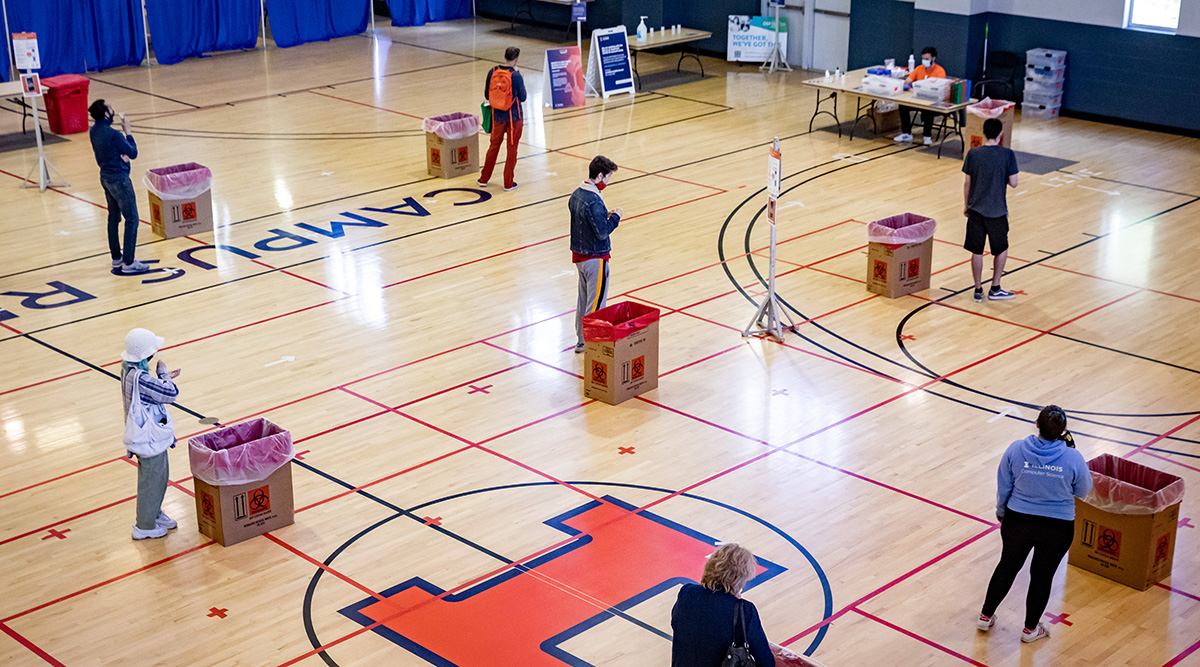Frequent COVID-19 testing key to efficient, early detection, study finds
The chance of detecting the virus that causes COVID-19 increases with more frequent testing, no matter the type of test, according to a new study. The tests can achieve 98% sensitivity if deployed at least every three days.
The study participants included students and employees at the University of Illinois who had tested positive for COVID-19 or were identified as close contacts of a person who tested positive. The SHIELD Illinois screening program, which required students and employees to take multiple saliva-based tests each week, and returned results in less than 24 hours, provided the ideal platform for identifying cases before they became symptomatic.

“This study was incredibly complex and would not have been possible without the personal or physical infrastructure provided by the IGB,” said Christopher Brooke (IGOH), the study leader and an assistant professor of microbiology. “We needed lab space, project managers, lab technicians, drivers, and IT staff. Fortunately, we put together an amazing team that consisted of people who were proactive, creative, and flexible in how they approached the problems.”
There was a total of 212 participants and data from 43 of the participants were included in the study. The researchers were able to establish a pipeline where they could collect the samples, transport them to the lab, and process them without interacting with other IGB personnel who were not a part of the project.
“Even scheduling the sample pick up posed a problem,” said Shannon Bradley, a project manager at the National Center for Supercomputing Applications at the University of Illinois. “If someone was in quarantine, we needed to figure out how they could safely give it to the drivers without exposing anybody else.”
“We were building the airplane as we were flying it,” said Darci Edmonson, the study’s Program Coordinator and IGB Special Events Coordinator. “Many of us on the team had never met in person—we still haven’t—and yet we had to tackle new challenges together every day. We felt that we had finally perfected our approach just as we were finishing the project.”
The study participants received three tests daily for 14 days: a PCR nasal swab, a PCR saliva test and an antigen nasal swab. The results of each were compared with live viral cultures taken from the PCR nasal swab, which show when a person is actively infectious. The study also examined how the frequency of testing affected each method’s efficacy at detecting an infection.
“Different tests have different advantages and limitations. Antigen tests are fast and cheap, but they are not as sensitive as PCR tests, which are the gold standard, but take some time to return results and are more expensive,” said Rebecca Lee Smith (IGOH), a professor of epidemiology and the first author of the study. “This study was to show, based on real data, which test is best under which circumstances and for what purpose.”
The results showed that the PCR tests – particularly saliva-based ones – were best at detecting cases before the person had an infectious viral load, a key to isolating individuals before they can spread the virus, Smith said. For all three methods, testing every three days had 98% sensitivity to detecting infection.
If testing frequency declined to once a week, the PCR methods maintained their high sensitivity but the antigen tests dropped to around 80%. Consequently, organizations that wish to deploy antigen testing as part of a reopening strategy or individuals who wish to monitor their status at home should use antigen tests multiple times each week to achieve similar results to PCR testing.
The results of the study helped inform the U.S. Food and Drug Administration’s recommendations and instructions on how to use at-home antigen tests that recently received emergency use authorization. The researchers said they hope the results assist schools, businesses and other organizations as they reopen.
“If you are in a situation where you have the resources and capacity to do large-scale PCR testing with rapid results reporting like we did here at Illinois, you can identify infections early and potentially isolate people before they become contagious,” Brooke said. “In places where PCR testing is not readily available, but the cheaper and more rapid tests are available, our data show how those tests can be deployed in a way that can increase their sensitivity – through repeated serial testing, ideally three times a week or more.”
Part of the Rapid Acceleration of Diagnostics Tech program of the National Institutes of Health, the study brought together researchers at Illinois; the University of Massachusetts Medical School, Worcester; Johns Hopkins School of Medicine, Baltimore; and the NIH National Institute of Biomedical Imaging and Bioengineering.
The study “Longitudinal assessment of diagnostic test performance over the course of acute SARS-CoV-2 infection” was published in the Journal of Infectious Diseases and can be found at https://doi.org/10.1093/infdis/jiab337. The study was conducted with support from the NIH RADx-Tech program under grant U54 HL143541-02S2.
